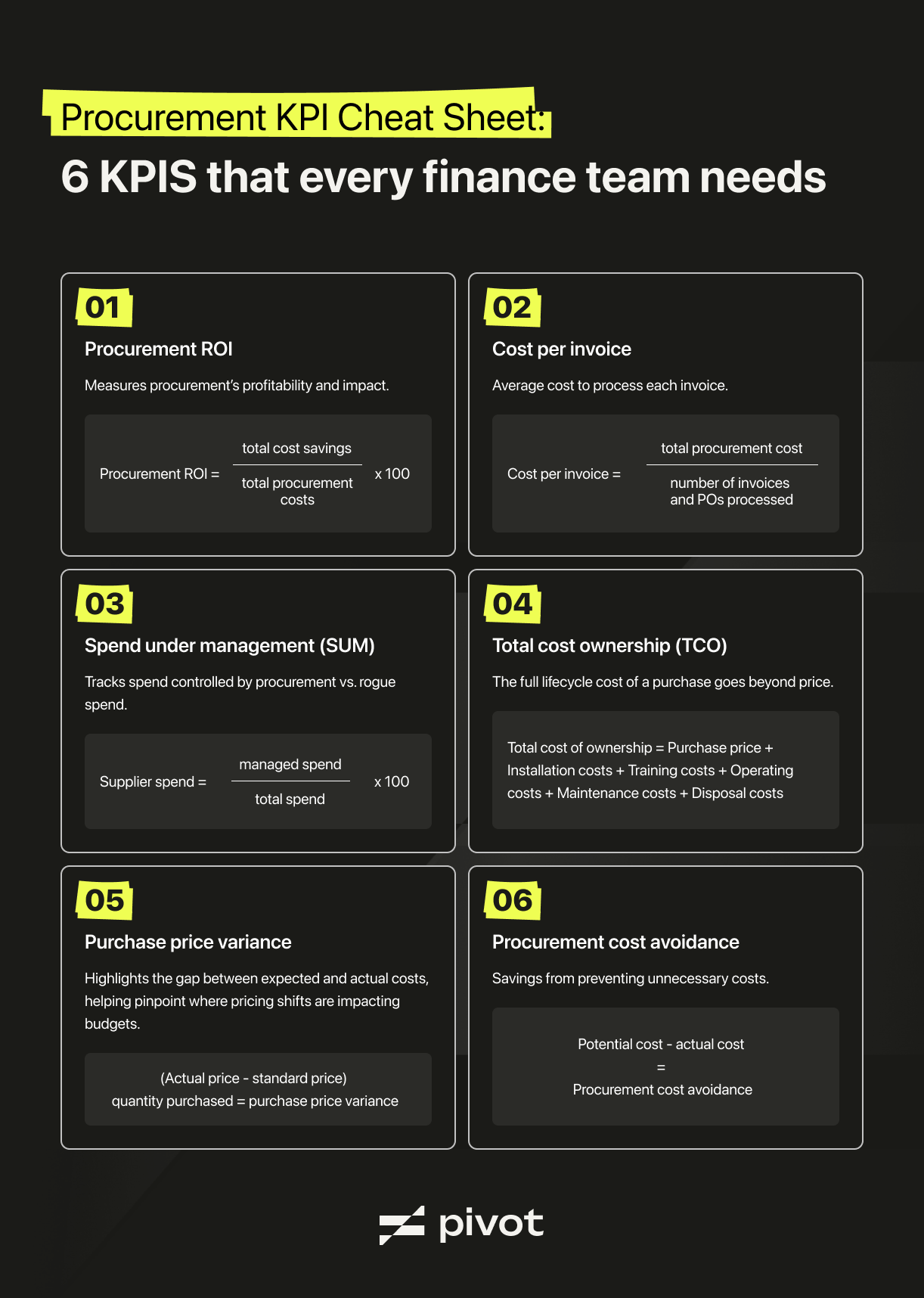Six Procurement KPIS that Every Finance Team Needs to Track
If your CFO (or you are a CFO who) is asking for more visibility into spend savings and procurement functions, then this one’s for you. Procurement and finance teams must collaborate more than ever because companies cannot afford to miss or undervalue the significant financial benefits that strategic procurement delivers.
Metrics ≠ key performance indicators
KPIs go beyond raw data and are related to your strategic business objectives; they provide insights for strategic decision-making. Without procurement KPIs, it’s difficult to know the impact that your procurement function has until it’s too late, which you’ll want to avoid. To be clear, some KPIs can be metrics, but they alone are not.
Finance teams play a crucial role in ensuring an organization’s financial health and strategic direction. Tracking KPIs is fundamental to supporting these goals for several reasons:
- Visibility: Finance spots exactly where procurement dollars go, cutting guesswork, boosting forecasting accuracy, and nailing budgets.
- Control: Together, finance and procurement catch cost leaks early, stop rogue spending, and dodge supplier risks before they hit the bottom line.
- Impact: KPIs prove procurement’s worth, from slashing costs and avoiding waste to driving innovation and long-term growth.
We’ve picked six procurement KPIs that every finance team needs to keep a close eye on to fully unlock the power of procurement as a strategic function.
Six KPIS that every finance team needs to track

Cost per invoice
- Definition: This measures the average cost per invoice for an organization by taking into account direct and variable costs.
- Why you should track it: This allows decision-makers to shed light on where you can improve your operational efficiency to make well-informed strategic decisions.
Cost per invoice = total procurement cost/number of invoices and POs processed
Procurement ROI
- Definition: This is the cost-effectiveness and profitability of your procurement function.
- Why you should track it: It’s important because it tells you how procurement is impacting your bottom line.
Procurement ROI = (total cost savings/total procurement costs) x 100
Spend under management (SUM)
- Definition: Contracts, negotiations, and supplier relationships, to name a few. The SUM is essentially all of the spend controlled by your procurement team. Anything that falls out of this scope is considered ‘rogue spend’.
- Why you should track it:
Supplier spend = (managed spend/total spend) x 100
Total cost ownership (TCO)
- Definition: TCO encompasses all the total costs associated with a purchase throughout its entire lifecycle. An example is a marketing agency: initial agency fees, upgrade fees, etc.
- Why you should track it: By considering all of these associated costs, you will be able to make strategic decisions without solely taking purchases at face value by looking only at the purchase price.
Total cost of ownership = Purchase price + Installation costs + Training costs + Operating costs + Maintenance costs + Disposal costs
Purchase price variance
- Definition: This calculates the difference between the actual price and the budgeted price of goods and services.
- Why you should track it: This KPI helps sharpen your budgeting precision and shows where price shifts are hitting hardest.
(Actual price - standard price) quantity purchased = purchase price variance
Procurement cost avoidance
- Definition: It captures the value of avoiding inflated or non-essential procurement costs before they impact the budget.
- Why you should track it:
Potential cost- actual cost = Procurement cost avoidance
How to Track Procurement KPIs Effectively With Pivot
Tracking procurement KPIs requires more than manual spreadsheets and isolated reports. With Pivot’s full-suite S2P platform, you can automate data collection across procurement processes, from requisitions and purchase orders to invoicing and supplier management. This unified data foundation ensures accuracy and real-time visibility into key metrics.
Key steps to track KPIs effectively with Pivot include:
- Define Clear Ownership: Assign responsibility for each KPI to procurement and finance stakeholders to ensure accountability and follow-up.
- Set a Regular Cadence: Schedule routine KPI reviews (monthly or quarterly) integrated within Pivot’s reporting and dashboard tools to maintain focus and adapt strategies.
- Use Automated Dashboards: Leverage Pivot’s customizable dashboards and alerts to monitor KPI trends, spot anomalies, and share insights effortlessly with leadership.
- Integrate Financial Systems: Connect Pivot with ERP and accounting software to synchronize spend data, enhancing forecasting accuracy and budget control.
- Drive Continuous Improvement: Use KPI insights to target inefficiencies, refine procurement strategies, and demonstrate procurement’s strategic impact to the CFO and finance teams.
By harnessing Pivot’s end-to-end analytics and automation, finance teams no longer operate in the dark but proactively guide procurement to deliver measurable business value.
You can't measure what you don't track
Procurement KPIs aren’t just numbers; they’re signals. They tell you where your money’s going, how well your processes are working, and whether your procurement function is truly supporting your strategic goals. Without them, finance teams are flying blind. By defining ownership, setting a cadence, and using the right tools, you turn raw data into real insight. And with that insight, you’re not just reacting, you’re steering.
If your procurement metrics stop at cost, you might be missing the strategic signals that drive smarter decisions.
What would change if you tracked what really matters? Get in touch with Pivot to find out.
.svg)





.png)